Podcast: Play in new window | Download (Duration: 19:27 — 15.1MB)
This week’s episode is all about crocodiles, alligators, and their relations. Thanks to Damian, John Paul, and John Paul’s son for the recommendation!
A Chinese alligator:
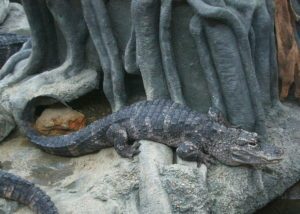
It’s easy to tell alligators and crocodiles apart. Just ask them to stand side by side, then lean over and look down to see the head shape. Broad-headed alligator on left, slender-headed crocodile on right:
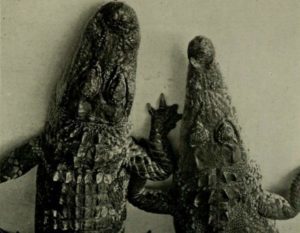
Saltwater crocodile. Look, I’m only going to say this once: DO NOT SIT ON A CROCODILE OKAY THAT IS JUST DUMB AND YOU WILL GET EATEN ONE DAY IF YOU KEEP ON DOING IT
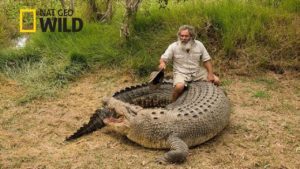
A gavial:
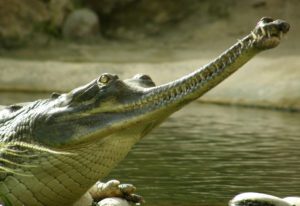
Black caiman:
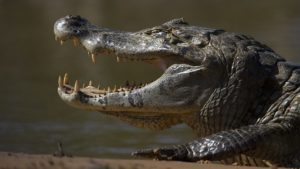
Further reading:
A newly discovered difference between alligators and crocodiles
Show transcript:
Welcome to Strange Animals Podcast. I’m your host, Kate Shaw.
This week’s episode is about crocodiles and alligators, and their relations. Thanks to a couple of different listeners for the suggestion, Damian and John Paul, and John Paul’s son. We’ve touched on crocodiles before in a couple of different episodes, including episode 53 about dragons, but alligators have barely had a mention.
Crocs and gators aren’t actually that closely related, but both are members of the order Crocodilia. This order also includes caimans and gavials, as well as some verrry interesting extinct members.
Crocodilians are amphibious reptiles. They spend much of their time in the water but also spend time on land. They breathe air, lay eggs, and depend on air or water temperature to regulate their body temperature. All crocodilians have evolved to take advantage of their watery habitat: long tails that are flattened laterally, eyes and nostrils close to the top of the head, short legs with webbed toes, and a flap at the back of the mouth that keeps water from flowing into the throat and airways. They can stay underwater for at least 15 minutes without needing to surface for air, and some individuals can stay underwater for close to two hours under the right conditions.
Crocodilians have thick protective scales on much of the body, called scutes, strengthened by osteoderms, or bony plates. Some scutes contain sensory receptors that sense touch, heat and cold, chemical stimuli, and especially the movement of water. Crocodilians see well even in darkness and have good hearing and smell too.
Some mother crocodilians lay her eggs in holes in the sand, but most build a nest out of vegetation. As the vegetation rots, it generates heat that warms the eggs. If the temperature in the nest is constantly above 90 degrees Fahrenheit, or 32 Celsius, more babies develop into males. If the temperature is cooler than that overall, more babies develop into females.
The mother protects the nest, which is usually near her den. Sometimes several females nest close to each other to help each other protect the nests. When her babies start hatching, the mother crocodilian digs them out of the nest since they aren’t strong enough to do it themselves, and carries the babies to water where they are safer. She also protects them for a while after they hatch. This is important, because baby crocodilians are vulnerable to predators—including adults of their own species.
Different species of crocodilians communicate in different ways. Some roar or bellow, some hiss, grunt, slap the jaws shut loudly, splash the head or tail in the water, or blow bubbles. Males often growl infrasonically—a sound humans feel more than hear, and which can cause the water around the male to shiver. That’s creepy. Baby crocodilians still in the egg will mimic tapping sounds, and yelp or grunt to let their mother know when they’re hatching.
One interesting thing about crocodilians is the way they walk. Most of the time a crocodilian walks with its belly touching the ground and its tail dragging. This is called the low walk. But unlike most other reptiles, most crocodilian species have ankle joints that allow it to raise its body up off the ground and walk like a mammal, with only the end of the tail dragging. This is called the high walk. Some smaller species can even run, a bounding gait something like a rabbit’s. Crocodilians can also jump.
If you’ve ever heard the phrase “crocodile tears,” which refers to someone who pretends to feel bad while doing something mean, it comes from the belief that crocodiles wept while eating their prey. The belief goes back at least 900 years and probably longer, and it’s actually based on a real phenomenon. When a crocodilian is in the water, its eyes are protected by both a see-through third eyelid, properly called a nictitating membrane, and by a tear-like lubricant that washes any grit out of the eye. The lubricant is visible when the animal is out of the water, and it looks like the crocodile is crying.
Many crocodilians are ambush hunters. They lie mostly submerged, only their eyes and nostrils above the surface of the water, and wait for an animal to approach. Then they grab the animal with their powerful jaws and drag it into the water to drown. This requires massive bite strength, and crocodilians have the strongest bite of any animal alive. Recently, 3D modeling of an alligator’s head revealed a second jaw joint that stabilizes the jaw and helps distribute the bite force throughout the skull.
In case you were wondering how to tell a crocodile from an alligator, crocodile snouts are more slender than alligator snouts. It’s easy to tell the two apart when their mouths are closed, since only the upper teeth are visible when an alligator closes its mouth, while a crocodile shows both upper and lower teeth.
Besides, there are only two species of alligator alive today, the American alligator that lives in the southern United States, and the Chinese alligator, which lives in eastern China. The Chinese alligator is the smaller species, no more than 7 feet long, or 2.1 meters. While most crocodilians have soft bellies, the Chinese alligator has an armored belly. It lives in marshes, lakes, and rivers but these days it’s critically endangered and mostly restricted to the Anhui Chinese Alligator Nature Reserve. In 1999, conservationists estimated that there were only about 150 Chinese gators alive in the wild. Fortunately, since then more protected habitats have been developed for the gators and captive breeding programs have released many young gators into the wild. Their numbers in the wild are increasing slowly, but since the gators also do well in captivity, it’s estimated that as many as 10,000 individuals live in zoos around the world.
As for the American alligator, back in 1967 it was listed as endangered, mostly due to hunting and the sale of baby alligators as pets. Alligators do not make good pets, which you could probably figure out just by thinking about how big gators get. That would be more than 15 feet long for a big male, or 4.6 meters. Fortunately, conservation made a huge difference to the American alligator and it’s now considered fully recovered from its low point in the 1960s.
The American alligator lives in wetlands throughout the deep southern states, including parts of Texas, across to Florida and up through parts of North Carolina. It eats pretty much anything it can catch, including fish, crabs and other crustaceans, birds, mammals, frogs and other amphibians, and reptiles like turtles and snakes. It also sometimes eats fruit. Because the alligator can tolerate a certain amount of salt water, and frequently lives near the ocean, occasionally one will eat a shark. But sharks sometimes eat alligators too. Alligators also help control the spread of exotic species released in the Florida Everglades and other areas, including Burmese pythons. Full-grown alligators frequently hunt on land, but young alligators mostly stay in the water. Young American alligators have thin yellowish stripes that fade as the gator grows.
There’s another crocodilian with a range that overlaps with that of the American alligator, the American crocodile. It’s usually paler in color than the alligator with a relatively narrow snout. It mostly lives in central America, but some do live in southern Florida, which makes southern Florida the only place in the world where gators and crocs live side by side in the wild. But crocodiles can’t tolerate cool weather as well as alligators, so cold snaps in Florida can kill off crocodiles while not harming alligators. Occasionally a big alligator will eat a smaller crocodile, but on average the croc is the bigger animal. Big males can occasionally grow over 20 feet long, or 6.1 meters. It frequently lives in salt water where it mostly eats fish and birds, along with small mammals, reptiles, amphibians, and crustaceans. It especially likes to eat lemon sharks. I mean, who wouldn’t, right? They sound delicious. Or maybe I just like lemons.
Unlike the American alligator, the American crocodile is endangered due to habitat loss, poaching, and pollution. It’s more dangerous to humans than the alligator, but not nearly as dangerous as some other species of crocodile.
The saltwater crocodile and the Nile crocodile are the most dangerous species to humans. The Nile crocodile can grow over 21 feet long, or almost 6.5 meters, and lives throughout much of Africa. The saltwater crocodile is the biggest crocodilian alive, and can grow up to 23 feet long, or 7 meters.
Like the American crocodile, the saltwater crocodile can tolerate salt water and frequently lives in coastal areas like the mouths of rivers, lagoons, and mangrove swamps. It’s found in parts of India down to northern Australia, and occasionally one will swim across the ocean to areas far from its usual range, including Japan and Fiji. Saltwater crocodiles, especially males, are territorial, and researchers think that about half of attacks on humans result from the human straying into a croc’s territory. These attacks aren’t usually fatal, but I bet they’re scary.
There are other crocodilians besides just the alligator and the crocodile. The gavial, also called the gharial or fish-eating crocodile, has a long, narrow snout that helps it catch the fish it eats. It lives in parts of India these days, in a few rivers and along the coasts, since it can tolerate salt water. It used to live throughout India and other parts of Asia, but it’s been hunted almost to extinction. In 1976 conservationists estimated that there were fewer than 200 gavials alive in the wild. Even after India put protections in place for the gavial, it continued to decline. In 2006 there were only 182 adult gavials alive. Conservationists are working hard to increase the population, including breeding them in captivity and releasing the babies into protected wildlife preserves in the wild. The main problems these days are loss of habitat and pollution, everything from dams across the rivers where it lives, heavy metal poisoning from polluted water, and drowning after entanglement in fishing nets. But population numbers have grown thanks to the conservation efforts, although there are probably fewer than 1,000 in the wild today.
The gavial can grow as long as the saltwater crocodile, although it’s usually much less heavy, with the longest measured at 23 feet long, or 7 meters. Adult males have a bulb at the end of their snouts that researchers think help them blow bubbles and make hissing and buzzing sounds that attract females.
Baby gavials eat tadpoles, frogs, and small fish. Adults eat fish and crustaceans. The gavial’s jaws are too delicate for it to feed on larger prey. In the past, hunters found jewelry in gavial stomachs and assumed they were maneaters, but it’s more likely they just swallowed jewelry lost in the river because it was shiny like fish scales.
There’s also a false gharial, which looks superficially like a gavial but has a broader snout. It’s reddish-brown with black splotches and some striping on the back and tail. These days it only lives in swamps in Indonesia and some nearby areas, although it used to have a broader range and also lived in rivers and lakes. Like the gavial, it’s been hunted to extinction in much of its former range for its skin and meat, and because people are afraid of it. It’s also vulnerable to habitat loss, including water pollution and draining of wetlands. It eats fish and other water animals, but it also preys on birds and mammals, and can grow more than 13 feet long, or 4 meters.
Caimans are most closely related to alligators and live in Central and South America. Some species are relatively small, from the 5 foot long, or 1.5 meter, Cuvier’s dwarf caiman, to the black caiman that can grow over 16 feet long, or 5 meters. Some researchers think the black caiman may occasionally grow up to 20 feet long, or 6 meters. Caiman scales are stiffened by calcium deposits, which makes caiman hide less valuable to leatherworkers than other crocodilian hides because it’s less pliable.
All crocodilians share an ancestor that lived around 240 million years ago. That same ancestor was also the ancestor of the dinosaurs. So it’s no surprise that crocodilians are considered the closest living bird relatives.
Paleontologists have discovered many extinct crocodilians, some of which look really strange. Mourasuchus, for instance, was a type of caiman that lived in South America during the Miocene, around 13 million years ago. Mourasuchus had long, flat jaws that looked something like a duck’s bill full of tiny conical teeth. Researchers think it may have been a filter feeder, filtering small animals from the mud at lake bottoms. But it was enormously big, some 39 feet long, or 12 meters.
Another possible filter feeding crocodilian was Stomatosuchus, which lived in Northern Africa around 95 million years ago and grew to 33 feet long, or 10 meters. It had a long, flat snout with small conical teeth in the upper jaw and may have had no teeth in the lower jaw. Some researchers think it might have had a pouched lower jaw like a pelican, which it used to catch small fish. It would suck in water, filling its pouch, then close its jaws and push the water out through its teeth. Any fish or other animals left in its mouth when all the water was expelled, it swallowed. But we don’t know for sure because only one Stomatosuchus skull has ever been found, and it was destroyed in 1944 when the museum it was in was bombed during World War II.
Purussaurus was another extinct caiman that lived in South America around 5 to 20 million years ago, and is estimated to grow as much as 41 feet long, or 12.5 meters. We don’t know its length for sure since we don’t have a complete skeleton, but if estimates are right, it was one of the biggest crocodilians that ever lived. It had a strong skull and huge teeth that allowed it to hold onto large prey.
Sarcosuchus was about the same size as Purussaurus, around 40 feet long, or 12 meters, but lived about 112 million years ago in what is now Africa and South America. It ate dinosaurs.
The largest living crocodilian ever reliably measured was a captive saltwater crocodile from the Philippines. He was captured in 2011 after rumors started that he had killed at least two people. He was kept on display in a wildlife center, and caretakers named him Lolong after one of the men who helped capture him. Lolong the crocodile was measured at 20 feet 3 inches long, or 6.17 meters, and he weighed 2,370 lbs, or 1,075 kg.
But crocodilians even larger than Lolong have been measured, just not by wildlife experts. Another saltwater crocodile in India has been estimated at 23 feet, or 7 meters, and a saltwater croc skull from Cambodia suggests that the living animal might also have been 23 feet long. A crocodile killed in Queensland, Australia in 1958 was supposedly 28 feet 4 inches long, or 8.64 meters, but this is probably an exaggeration.
But size is relative. A crocodilian that lived in South America some 60 million years ago and grew to a respectable 18 feet long, or 5.5 meters, probably got eaten by the largest known snake that ever lived, titanoboa. Titanoboa grew up to 42 feet long, or 12.8 meters. But that is a story for another day.
You can find Strange Animals Podcast online at strangeanimalspodcast.com. We’re on Twitter at strangebeasties and have a facebook page at facebook.com/strangeanimalspodcast. If you have questions, comments, or suggestions for future episodes, email us at strangeanimalspodcast@gmail.com. If you like the podcast and want to help us out, leave us a rating and review on Apple Podcasts or whatever platform you listen on. We also have a Patreon if you’d like to support us that way.
Thanks for listening!